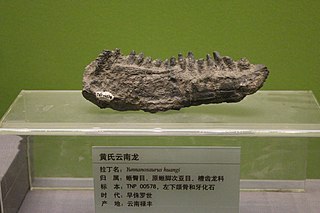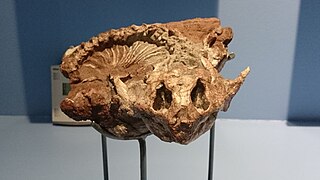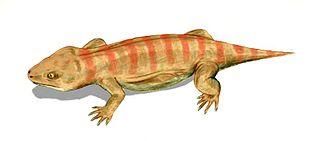
Yunnanosaurus is an extinct genus of sauropodomorph dinosaur that lived approximately 199 to 183 million years ago in what is now the Yunnan Province, in China, for which it was named. Yunnanosaurus was a large sized, moderately-built, ground-dwelling, quadrupedal herbivore, that could also walk bipedally, and ranged in size from 7 meters (23 feet) long and 2 m (6.5 ft) high to 4 m (13 ft) high in the largest species.
Vytshegdosuchus is an extinct genus of paracrocodylomorph archosaur known from the Early Triassic Yarenskian Gorizont of the Komi Republic of the European section of Russia. It contains a single species, Vytshegdosuchus zheshartensis. Vytshegdosuchus was named by Andreii Sennikov in 1988.
Kitchingnathus is an extinct genus of basal procolophonid parareptile from Early Triassic deposits of Eastern Cape Province, South Africa. It is known from the holotype BP/1/1187, skull and partial postcranium, which was first assigned to the more derived Procolophon trigoniceps. It was collected by the South African palaeontologist, James W. Kitching in October 1952 from Hobbs Hill, west of Cathcart. It was found in the middle or upper part of the Katberg Formation of the Beaufort Group and referred to the uppermost Lystrosaurus Assemblage Zone. It was first named by Juan Carlos Cisneros in 2008 and the type species is Kitchingnathus untabeni. The generic name honours James W. Kitching, and "gnathus", from Greek gnathos meaning mandible. The specific name meaning "from the hill", in isiZulu, is in reference to the locality where the fossil was found.

Sauropareion is an extinct genus of basal procolophonid parareptile from earliest Triassic deposits of Eastern Cape Province, South Africa. It is known from the holotype SAM PK-11192, skull and partial postcranium. It was collected by the late L. D. Boonstra in 1935 from Barendskraal in the Middelburg District and referred to the Lystrosaurus Assemblage Zone of the Beaufort Group. It was first named by Sean P. Modesto, Hans-Dieter Sues and Ross J. Damiani in 2001 and the type species is Sauropareion anoplus. The generic name means "lizard", sauros, and "cheek", pareion from Greek in reference to the lizard-like appearance of the temporal region. The specific name comes from the Greek word anoplos, meaning "without arms or armour".
Pintosaurus is an extinct genus of basal procolophonid parareptile from Late Triassic deposits of northeastern Uruguay. It is known from the holotype FC-DPV 1181, a partial skull. It was collected from the Buena Vista Formation of the Paraná Basin, in Colonia Orozco, Cerro Largo Department. It was first named by Graciela Piñeiro, Alejandra Rojas and Martín Ubilla in 2004 and the type species is Pintosaurus magnidentis. The generic name honours Dr. Iraja Damiani Pinto. The specific name means "with a large tooth" in Latin, a reference to the large palatal tooth pair.
Theledectes is an extinct genus of theledectine procolophonid parareptile from middle Triassic deposits of Free State Province, South Africa.The type species, Theledectes perforatus, is based on the holotype BP/1/4585, a flattened skull. This skull was collected by the South African palaeontologist, James W. Kitching from Hugoskop in the Rouxville District and referred to subzone B of the Cynognathus Assemblage Zone of the Burgersdorp Formation, Beaufort Group. The genus was first named by Sean P. Modesto and Ross J. Damiani in 2003. However, the species was initially assigned to the genus Thelegnathus by C.E. Gow in 1977, as the species Thelegnathus perforatus.
Phaanthosaurus is an extinct genus of basal procolophonid parareptile from early Triassic deposits of Nizhnii Novgorod, Russian Federation. It is known from the holotype PIN 1025/1, a mandible. It was collected from Vetluga River, Spasskoe village and referred to the Vokhmian terrestrial horizon of the Vokhma Formation. It was first named by P. K. Chudinov and B. P. Vjushkov in 1956 and the type species is Phaanthosaurus ignatjevi.
Largocephalosaurus is an extinct genus of basal saurosphargid, a marine reptile known from the Middle Triassic Guanling Formation of Yunnan and Guizhou Provinces, southwestern China. It contains a type species, Largocephalosaurus polycarpon, and a second species L. qianensis.

Teratophon is an extinct genus of procolophonine procolophonid parareptile from middle Triassic deposits of Free State Province, South Africa. It is known from the holotype BP/1/4299, a nearly complete skull. It was collected by the South African palaeontologist, James W. Kitching from Hugoskop in the Rouxville District and referred to subzone B of the Cynognathus Assemblage Zone of the Burgersdorp Formation, Beaufort Group. It was first named by Sean P. Modesto and Ross J. Damiani in 2003 and the type species is Teratophon spinigenis. It was first assigned to a species of Thelegnathus, Thelegnathus spinigenis.
Thelephon is an extinct genus of procolophonine procolophonid parareptile from middle Triassic deposits of Free State Province, South Africa. It is known from the holotype BP/1/3512, a partial skull lacking the snout and anterior third of the mandible. It was collected by the South African palaeontologist, James W. Kitching from Hugoskop in the Winnaarsbaken and referred to subzone B of the Cynognathus Assemblage Zone of the Burgersdorp Formation, Beaufort Group. It was first named by Sean P. Modesto and Ross J. Damiani in 2003 and the type species is Thelephon contritus. It was first assigned to a species of Thelegnathus, Thelegnathus contritus.
Thelerpeton is an extinct genus of procolophonine procolophonid parareptile from middle Triassic deposits of Free State Province, South Africa. It is known from the holotype BP/1/4538, a nearly complete skull. It was collected by the South African palaeontologist, James W. Kitching from Hugoskop in the Rouxville District and referred to subzone B of the Cynognathus Assemblage Zone of the Burgersdorp Formation, Beaufort Group. It was first named by Sean P. Modesto and Ross J. Damiani in 2003 and the type species is Thelerpeton oppressus. It was first assigned to a species of Thelegnathus, Thelegnathus oppressus.
Timanophon is an extinct genus of procolophonine procolophonid parareptile from early Triassic deposits of Arkhangelsk, Russia. It is known from the holotype PIN 3359/11, a partial skeleton including nearly complete skull and lower jaw which was previously referred to Burtensia sp. by Ivakhnenko in 1975. It was collected in the Mezenskaya Pizhma and Lower Syamzhen'ga localities from the Pizhmomezenskoi Formation. Ten additional specimens from the same localities are PIN 3359/1-3, 3359/63-65 and 4364/35-38. The fragmentary dentaries PIN 3360/1-3 were collected in the Vybor River locality, from the same formation. All specimens came from the Ustmylian Gorizont, dating to the early Olenekian faunal stage of the Early Triassic, about 249-247 million years ago. It was first named by I. V. Novikov in 1991 and the type species is Timanophon raridentatus.
Anomoiodon is an extinct genus of procolophonine procolophonid parareptile from early Triassic deposits of Thuringia, Germany. It is known only from the holotype MB.R.3539B and paratype MB.R.3539A, two articulated, three-dimensionally preserved partial skeletons on one block which represent two individuals. The holotype includes nearly complete skull and lower jaw. The block was collected from the lowest layer of the Chirotherium Sandstone Member of the Solling Formation, dating to the early Olenekian faunal stage of the Early Triassic, about 249-247 million years ago. It was first named by Friedrich von Huene in 1939 and the type species is Anomoiodon liliensterni. Laura K. Säilä, who redescribed Anomoiodon in 2008, found it to be a leptopleuronine using a phylogenetic analysis. The most recent analysis, performed by Ruta et al. (2011) found it to be a procolophonine instead. However, both analyses found that it is most closely related to the Russian procolophonid Kapes.

Procolophoninae is an extinct subfamily of procolophonid parareptiles from the late Early Triassic to the early Middle Triassic of Africa, Antarctica, Asia, Europe and South America. Currently, the oldest-known procolophonine is Procolophon from the earliest Olenekian stage.
Pentaedrusaurus is an extinct genus of procolophonid parareptile from the Early Triassic of China. It is one of the most basal members of the procolophonid subfamily Leptopleuroninae. The only known species of Pentaedrusaurus, P. ordosianus, was named in 1989 from the Heshanggou Formation.
Sanchiaosaurus is an extinct genus of a basal nothosauroid known from the Middle Triassic of Guizhou Province, southwestern China. It contains a single species, Sanchiaosaurus dengi.
Kwangsisaurus is an extinct genus of a basal pistosauroid known from the Early or Middle Triassic of Guangxi, southern China. It contains a single species, Kwangsisaurus orientalis.
Eohyosaurus is an extinct genus of basal rhynchosaur known from the early Middle Triassic Burgersdorp Formation of Free State, South Africa. It contains a single species, Eohyosaurus wolvaardti.
Doniceps is an extinct genus of reptile from the Early Triassic of European Russia known from the type species D. lipovensis. It was solely known from the holotype premaxilla 104/3106 housed at Saratov University, however the specimen is probably lost. It was collected at the Donskaya Luka Locality near the village of Sirotinskaya in Ilovlinsky District, Volgograd Oblast, from the Lipovskaya Formation of the Gamskii Horizon. The generic name refers to the nearby Don River added the Greek suffix for "head", -ceps. The specific name is derived from the name of the type locality Donskaya Luka, also known as Lipovaya Balka. Named by Otschev and Rykov in 1968 as an archosauromorph, Arkhangelskii & Sennikov (2008) classified the taxon as a possible trilophosaurid. Doniceps is thought to be similar to Coelodontognathus and Vitalia, both of which are known exclusively from the same locality and were first identified as procolophonids but later reclassified as trilophosaurids.
Vitalia is an extinct genus of reptile from the Early Triassic of European Russia known from the type species V. grata. It is known from the holotype dentary PIN 4173/126 as well as two additional dentaries PIN 1043/627 and 1043/628, all housed at the Paleontological Institute, Russian Academy of Sciences. The type dentary was originally included in the hypodigm of Coelodontognathus donensis named by the notable Russian vertebrate paleontologist Vitaliy Georgiyevich Ochev in 1967. Ivakhnenko (1973) separated the specimen and gave it its own genus and species name in light of the new material, which he named in honor of Ochev. The dentaries of Vitalia were collected at the Donskaya Luka Locality near the village of Sirotinskaya in Ilovlinsky District, Volgograd Oblast, from the Lipovskaya Formation of the Gamskii Horizon. Like Coelodontognathus, Vitalia was originally described as a procolophonid parareptile in 1973, but Arkhangelskii & Sennikov (2008) reclassified the taxon as a possible trilophosaurid archosauromorph. Vitalia is thought to be similar to the possible trilophosaurids Coelodontognathus and Doniceps, both of which are known exclusively from the same locality. Coelodontognathus and Vitalia are similar to procolophonids in that they have wide teeth but differs from them in that they have tooth roots set deep into the jaws.











